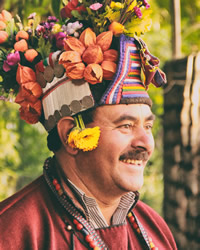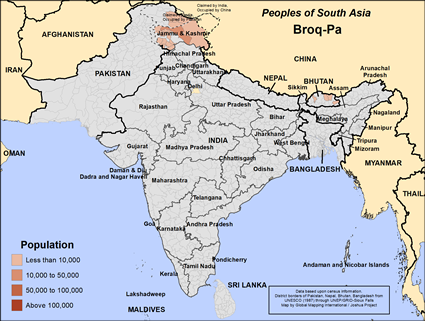The official classification of the Dokhpa in India appears to include three sub-ethnicities: the Broq-Pa, Dard and Shin. The Broq-Pa should not be mistaken for other similarly named groups in the Himalayan Region. Broq-Pa is a name also given to this group by the Ladakhi people.
Broq-Pa Dokhpa people live in northern India, along the Indus River in Ladakh and Kargil districts of the state of Jammu and Kashmir. Their villages are named Garkun, Darchik, Chulichan, Gurgurdo, Batalik and Da. They formerly lived in Hanu village as well, but now no Broq-Pa people appear to live there. There may be a small number of Dokhpa living in Pakistan-controlled Kashmir.
Although they live in the same area as the Ladakhi, the Broq-Pa are distinguished by their linguistic differences and also by appearance. The Broq-Pa wear headgear and a gown, the former being decorated with flowers, beads, needles, ribbons and buttons. Both men and women are particularly fond of flowers. Women style their hair in plaits while men shave the front portion of the head and have a long pigtail. The men and women cover their body with goat skin, lined inside with fur.' The main staple food of the Dokhpa is roasted barley flour, called sattu. Certain foods, such as beef, cow's milk, birds and eggs, are strictly taboo because of religious and superstitious beliefs.
Buddhist priests (lamas) conduct their marriage ceremonies at the bride's place. When someone dies, the lama is called upon to assist the chief mourner to conduct the funeral rites. They cremate the dead in a lying posture and a member of the clan lights the funeral pyre. They bury the remaining bones after the cremation.
While all of the closest ethnolinguistic relatives of the Dokhpa people are Muslims living in Pakistan and Afghanistan, most Broq-Pa in India follow Tibetan Buddhism. They worship La, Dogla and Sapdak through animal sacrifices. They also believe in demons. Smaller numbers of Broq-Pa people follow their traditional animistic religion while a few have converted to Islam.
Few Broq-Pa people have ever been exposed to the gospel. Although there are Christians among the neighboring Ladakhi, few are engaged in sharing their faith. The Broq-Pa people need to accept the warm embrace of the only savior so they can enjoy spiritually meaningful lives.
Pray for the authority of Christ to bind hindering spiritual forces to lead them from darkness to light.
Pray for signs and wonders among them and for great breakthroughs with a rapid multiplication of disciples and house churches.
Pray for bold workers who are driven by the love of the Holy Spirit to go to them.
Pray for an unstoppable movement to Christ among them.
Scripture Prayers for the Broq-Pa in India.
Peoples of the Buddhist World, Asia Harvest, Copyrighted © Used with permission
| Profile Source: Joshua Project |











